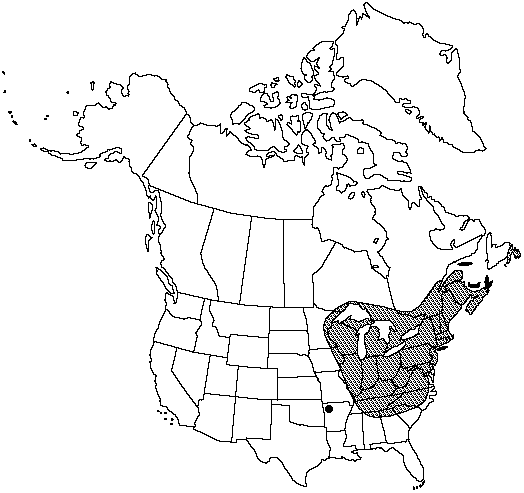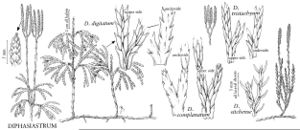Difference between revisions of "Diphasiastrum digitatum"
Preslia 47: 108. 1975.
FNA>Volume Importer |
imported>Volume Importer |
||
| (7 intermediate revisions by 2 users not shown) | |||
| Line 8: | Line 8: | ||
}} | }} | ||
|common_names=Southern running-pine;lycopode en éventail | |common_names=Southern running-pine;lycopode en éventail | ||
| − | |basionyms={{Treatment/ID/ | + | |basionyms={{Treatment/ID/Basionym |
|name=Lycopodium digitatum | |name=Lycopodium digitatum | ||
|authority=Dillenius ex A. Braun | |authority=Dillenius ex A. Braun | ||
| + | |rank=species | ||
| + | |publication_title=Amer. J. Sci. Arts, ser. | ||
| + | |publication_place=2, 6: 81. 1848 | ||
}} | }} | ||
|synonyms={{Treatment/ID/Synonym | |synonyms={{Treatment/ID/Synonym | ||
|name=Lycopodium complanatum var. flabelliforme | |name=Lycopodium complanatum var. flabelliforme | ||
|authority=Fernald | |authority=Fernald | ||
| − | }}{{Treatment/ID/Synonym | + | |rank=variety |
| + | }} {{Treatment/ID/Synonym | ||
|name=Lycopodium flabelliforme | |name=Lycopodium flabelliforme | ||
|authority=(Fernald) Blanchard | |authority=(Fernald) Blanchard | ||
| + | |rank=species | ||
}} | }} | ||
|hierarchy=Lycopodiaceae;Diphasiastrum;Diphasiastrum digitatum | |hierarchy=Lycopodiaceae;Diphasiastrum;Diphasiastrum digitatum | ||
| Line 26: | Line 31: | ||
}}<!-- | }}<!-- | ||
| − | --><span class="statement" id="st- | + | --><span class="statement" id="st-undefined" data-properties=""><b>Horizontal </b>stems on substrate surface, 1.3–2.7 mm wide; leaves appressed to ascending, linear to narrowly lanceolate, 1.8–4.5 × 0.6–1.2 mm, apex acute, scarious, often lost. <b>Upright</b> shoots 15–50 cm, branching regularly successively to 3 times; leaves appressed with decurrent base, subulate, 1.8–3.5 × 0.6–1 mm, apex acute. <b>Branchlets</b> flat in cross section, narrowly bladelike, 2.8–3.9 mm wide, annual bud constrictions very rare; underside dull, pale, flat; upperside green, flat, shiny. <b>Leaves</b> of branchlets 4-ranked; upperside leaves appressed, linear-lanceolate, free portion of blade 0.7–1.5 × 0.5–0.9 mm; lateral leaves appressed to spreading (spreading especially in juvenile stages), 3.1–5.5 × 1–2 mm; underside leaves very weakly developed, spreading, narrowly deltate, 0.3–1 × 0.3–0.7 mm, apex pointed. <b>Peduncles</b> mostly 2, 4.4–12.5 × 0.1–1.3 cm; leaves usually somewhat whorled, linear-lanceolate to nearly filiform, 2–3.3 × 0.5–0.9 mm, apex blunt to acute. <b>Stalks</b> mostly pseudowhorled, 2-forked, forks basal. <b>Strobili</b> 2–4 per upright shoot, 14–40 × 2–3 mm exclusive of elongate sterile tip; sterile tips to 11 mm (occurring on ca. 50% of specimens), apex blunt to acute if sterile tip is absent. <b>Sporophylls</b> deltate, 1.7–2.6 × 1.8–2.8 mm, apex abruptly tapering. <b>2n</b> = 46.</span><!-- |
-->{{Treatment/Body | -->{{Treatment/Body | ||
|habitat=Coniferous and hardwood forests and second growth, shrubby or open fields | |habitat=Coniferous and hardwood forests and second growth, shrubby or open fields | ||
|elevation=0–1500 m | |elevation=0–1500 m | ||
| − | |distribution=St. Pierre and Miquelon;N.B.;Nfld.;N.S.;Ont.;P.E.I.;Que.;Ala.;Ark.;Conn.;Del.;D.C.;Ga.;Ill.;Ind.;Iowa;Ky.;Maine;Md.;Mass.;Mich.;Minn.;Mo.;N.H.;N.J.;N.Y.;N.C.;Ohio;Pa.;R.I.;S.C.;Tenn.;Va.;W.Va.;Wis. | + | |distribution=St. Pierre and Miquelon;N.B.;Nfld. and Labr. (Nfld.);N.S.;Ont.;P.E.I.;Que.;Ala.;Ark.;Conn.;Del.;D.C.;Ga.;Ill.;Ind.;Iowa;Ky.;Maine;Md.;Mass.;Mich.;Minn.;Mo.;N.H.;N.J.;N.Y.;N.C.;Ohio;Pa.;R.I.;S.C.;Tenn.;Va.;W.Va.;Wis. |
| − | |discussion=<p>An endemic in eastern North America, Diphasiastrum digitatum is the most abundant species of Diphasiastrum on the continent, much used for decoration as wreaths. It was long confused with the circumboreal D. complanatum.</p> | + | |discussion=<p>An endemic in eastern North America, <i>Diphasiastrum digitatum</i> is the most abundant species of <i>Diphasiastrum</i> on the continent, much used for decoration as wreaths. It was long confused with the circumboreal <i>D. complanatum</i>.</p> |
|tables= | |tables= | ||
|references= | |references= | ||
| Line 41: | Line 46: | ||
-->{{#Taxon: | -->{{#Taxon: | ||
name=Diphasiastrum digitatum | name=Diphasiastrum digitatum | ||
| − | |||
|authority=(Dillenius ex A. Braun) Holub | |authority=(Dillenius ex A. Braun) Holub | ||
|rank=species | |rank=species | ||
| Line 50: | Line 54: | ||
|habitat=Coniferous and hardwood forests and second growth, shrubby or open fields | |habitat=Coniferous and hardwood forests and second growth, shrubby or open fields | ||
|elevation=0–1500 m | |elevation=0–1500 m | ||
| − | |distribution=St. Pierre and Miquelon;N.B.;Nfld.;N.S.;Ont.;P.E.I.;Que.;Ala.;Ark.;Conn.;Del.;D.C.;Ga.;Ill.;Ind.;Iowa;Ky.;Maine;Md.;Mass.;Mich.;Minn.;Mo.;N.H.;N.J.;N.Y.;N.C.;Ohio;Pa.;R.I.;S.C.;Tenn.;Va.;W.Va.;Wis. | + | |distribution=St. Pierre and Miquelon;N.B.;Nfld. and Labr. (Nfld.);N.S.;Ont.;P.E.I.;Que.;Ala.;Ark.;Conn.;Del.;D.C.;Ga.;Ill.;Ind.;Iowa;Ky.;Maine;Md.;Mass.;Mich.;Minn.;Mo.;N.H.;N.J.;N.Y.;N.C.;Ohio;Pa.;R.I.;S.C.;Tenn.;Va.;W.Va.;Wis. |
|reference=None | |reference=None | ||
|publication title=Preslia | |publication title=Preslia | ||
|publication year=1975 | |publication year=1975 | ||
|special status= | |special status= | ||
| − | |source xml=https:// | + | |source xml=https://bitbucket.org/aafc-mbb/fna-data-curation/src/2e0870ddd59836b60bcf96646a41e87ea5a5943a/coarse_grained_fna_xml/V2/V2_575.xml |
|genus=Diphasiastrum | |genus=Diphasiastrum | ||
|species=Diphasiastrum digitatum | |species=Diphasiastrum digitatum | ||
| − | |||
| − | |||
| − | |||
| − | |||
| − | |||
| − | |||
| − | |||
| − | |||
| − | |||
| − | |||
| − | |||
| − | |||
| − | |||
| − | |||
| − | |||
| − | |||
| − | |||
| − | |||
| − | |||
| − | |||
| − | |||
| − | |||
| − | |||
| − | |||
| − | |||
| − | |||
| − | |||
| − | |||
| − | |||
| − | |||
| − | |||
| − | |||
| − | |||
| − | |||
| − | |||
| − | |||
| − | |||
| − | |||
| − | |||
| − | |||
| − | |||
| − | |||
| − | |||
| − | |||
| − | |||
| − | |||
| − | |||
| − | |||
| − | |||
| − | |||
| − | |||
| − | |||
| − | |||
| − | |||
| − | |||
| − | |||
| − | |||
}}<!-- | }}<!-- | ||
-->[[Category:Treatment]][[Category:Diphasiastrum]] | -->[[Category:Treatment]][[Category:Diphasiastrum]] | ||
Latest revision as of 20:24, 5 November 2020
Horizontal stems on substrate surface, 1.3–2.7 mm wide; leaves appressed to ascending, linear to narrowly lanceolate, 1.8–4.5 × 0.6–1.2 mm, apex acute, scarious, often lost. Upright shoots 15–50 cm, branching regularly successively to 3 times; leaves appressed with decurrent base, subulate, 1.8–3.5 × 0.6–1 mm, apex acute. Branchlets flat in cross section, narrowly bladelike, 2.8–3.9 mm wide, annual bud constrictions very rare; underside dull, pale, flat; upperside green, flat, shiny. Leaves of branchlets 4-ranked; upperside leaves appressed, linear-lanceolate, free portion of blade 0.7–1.5 × 0.5–0.9 mm; lateral leaves appressed to spreading (spreading especially in juvenile stages), 3.1–5.5 × 1–2 mm; underside leaves very weakly developed, spreading, narrowly deltate, 0.3–1 × 0.3–0.7 mm, apex pointed. Peduncles mostly 2, 4.4–12.5 × 0.1–1.3 cm; leaves usually somewhat whorled, linear-lanceolate to nearly filiform, 2–3.3 × 0.5–0.9 mm, apex blunt to acute. Stalks mostly pseudowhorled, 2-forked, forks basal. Strobili 2–4 per upright shoot, 14–40 × 2–3 mm exclusive of elongate sterile tip; sterile tips to 11 mm (occurring on ca. 50% of specimens), apex blunt to acute if sterile tip is absent. Sporophylls deltate, 1.7–2.6 × 1.8–2.8 mm, apex abruptly tapering. 2n = 46.
Habitat: Coniferous and hardwood forests and second growth, shrubby or open fields
Elevation: 0–1500 m
Distribution

St. Pierre and Miquelon, N.B., Nfld. and Labr. (Nfld.), N.S., Ont., P.E.I., Que., Ala., Ark., Conn., Del., D.C., Ga., Ill., Ind., Iowa, Ky., Maine, Md., Mass., Mich., Minn., Mo., N.H., N.J., N.Y., N.C., Ohio, Pa., R.I., S.C., Tenn., Va., W.Va., Wis.
Discussion
An endemic in eastern North America, Diphasiastrum digitatum is the most abundant species of Diphasiastrum on the continent, much used for decoration as wreaths. It was long confused with the circumboreal D. complanatum.
Selected References
None.
